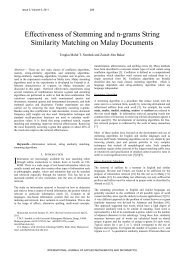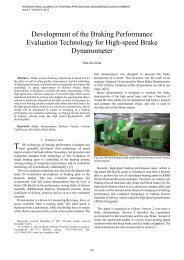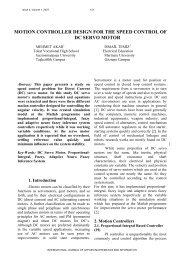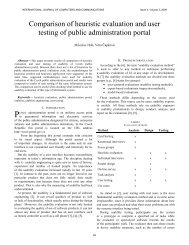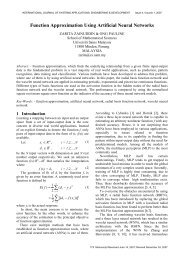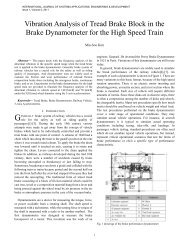Using MODIS 250 m Imagery to Estimate Total Suspended Sediment
Using MODIS 250 m Imagery to Estimate Total Suspended Sediment
Using MODIS 250 m Imagery to Estimate Total Suspended Sediment
Create successful ePaper yourself
Turn your PDF publications into a flip-book with our unique Google optimized e-Paper software.
INTERNATIONAL JOURNAL OF SYSTEMS APPLICATIONS, ENGINEERING & DEVELOPMENTIssue 1, Volume 3, 2009Comparison between these validation results indicated thatequation 3 was able <strong>to</strong> better estimate TSS in lowerconcentrations, but during higher concentrations it tended <strong>to</strong>underestimate this parameter. Although equation 1 showed ahigher RMSE, estimated values followed better the tendencyof observed values. The limitations of these algorithms canbe attributed <strong>to</strong> various fac<strong>to</strong>rs: (i) limited data representativeof high TSS concentrations, (ii) <strong>MODIS</strong> band 1 is not capableof detecting TSS signal under low concentrations conditions,(iii) the atmospheric correction method is not appropriate, and(iv) the presence of sea-bot<strong>to</strong>m effect in the signal. Anotherproblem that could be affecting the results is the mixing pixelphenomenon; which is a common and highly influenceproblem when trying <strong>to</strong> derive information from satelliteimagery [20]. In the case of TSS estimations, the mixingpixel occurs when variations in TSS concentrations or landand water areas are combined within the <strong>250</strong> m cover area of apixel. Occurrence of this phenomenon can be reduced byusing images with higher spatial resolution, but this alternativeis limited by current ocean color sensors.(b)D. <strong>Total</strong> <strong>Suspended</strong> <strong>Sediment</strong> ProductsEstimations of TSS were generated using the three developedalgorithms in order <strong>to</strong> spatially analyze results and compareefficiency of the equations. Figure 5 shows spatial variationsassociated <strong>to</strong> TSS concentration in Puer<strong>to</strong> Rico surroundingsareas and Mayagüez Bay for the dates used in the validationanalysis. The spatial variability observed in these productsappeared <strong>to</strong> respond by inshore processes showing higherconcentrations in areas closer <strong>to</strong> the shoreline which aretypical characteristics of coastal environments. In the case ofMayagüez Bay the majority of high values are concentrated inthe northern part of the bay where the Añasco River plume islocated. Comparison between all three different algorithmsdoes not indicate any significant difference between them; themain difference resides in algorithm 3 which range of valuesis considerably higher than the algorithm 1 and 2. Therefore,application of algorithm 3 resulted on sharper spatialvariations when comparing values in inshore and offshoreareas.(c)Figure 4. Validation results when applying (a) equation 1, (b)equation 2 and (c) equation 3.(a)40



